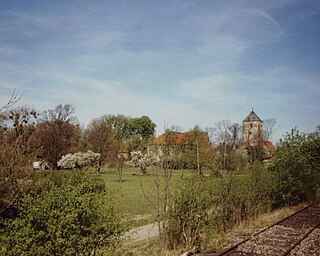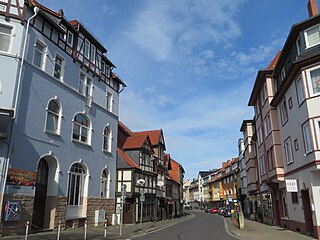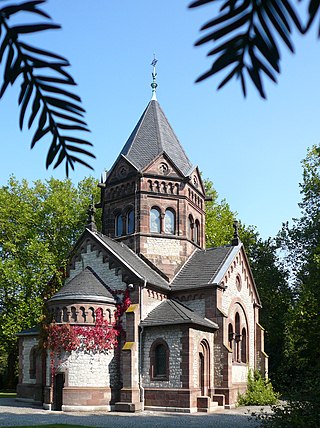
Hildesheim is a city in Lower Saxony, Germany with 101,693 inhabitants. It is in the district of Hildesheim, about 30 km (19 mi) southeast of Hanover on the banks of the Innerste River, a small tributary of the Leine River.

Marienrode Priory is a Benedictine nunnery in Marienrode, a district of Hildesheim in Germany.

Adelebsen is a municipality in the district of Göttingen, in Lower Saxony, Germany. It consists of the localities Adelebsen, Barterode, Eberhausen, Erbsen, Güntersen, Lödingsen and Wibbecke. The Burg Adelebsen is located on a high point in Adelebsen proper.

Rykestrasse Synagogue, Germany's largest synagogue, is located in the Prenzlauer Berg neighbourhood in the Pankow borough of Berlin. Johann Hoeniger built the synagogue in 1903/1904. It was inaugurated on 4 September 1904, in time for the holidays of and around Rosh Hashanah. The synagogue stands off the street alignment and is reached by a thoroughfare in the pertaining front building.

St. Martin's is a Lutheran church in Groß Ellershausen, Göttingen, Lower Saxony, Germany. It is significant as possibly retaining the oldest existing structure, its tower, in southern Lower Saxony. While the details of the origin of the church building have been lost in the mist of history, architectural analysis indicates that the Romanesque church tower was most likely built in the tenth or eleventh century. The remains of a hearth on the second floor have led to the conclusion that the tower was originally a Wohnturm of a titled family, probably the Herren von Ellershausen, which lived there at the time. The church's ship is much younger, probably having been built or re-built during the Barocque era. It was repaired in 1838..

The Historic Market Place is a historical structure in the city of Hildesheim in Lower Saxony, Germany

Marienburg Castle is a well-preserved Romanesque castle in Hildesheim, a city in Lower Saxony, Germany.

Steuerwald Castle is a Romanesque castle in Hildesheim, a city in Lower Saxony, Germany.
St. Bernward's Church is a Catholic church in the city of Hildesheim in Lower Saxony, Germany. The name refers to the bishop Bernward of Hildesheim (960-1022) who was canonized by Pope Celestine III.

Moritzberg is a quarter in the city of Hildesheim in Lower Saxony, Germany. It is on a hill in the west of the city, about a mile from the Cathedral. It was an independent market town until 1911.

The Hospital of the Five Wounds is a half-timbered house in the city of Hildesheim in Lower Saxony, Germany. It is in the southern part of the old city center, opposite St. Godehard and behind St. Nicolai's Chapel.

The history of the Jews in Cologne dates to 321 C.E., when it was recorded in a census decreed by the Emperor Constantine I. As such, it is the oldest European Jewish community north of the Alps. The community quickly established itself in what came to be known as Cologne's Jewish quarter, building its first synagogue by 1040 C.E. The Crusades put an end to peaceful coexistence with Christians in 1096 C.E. Despite the Archbishop's protection many Jews were killed and their synagogue destroyed. The community regained its economic and religious life until about 1300 C.E., when the Christian majority again applied pressure. The community's fortunes improved and worsened a number of times into the 20th century. Before the 1930s, it consisted of 19,500 people. After the end of World War II it had been almost entirely extinguished due to Nazi destruction, expulsion and murder. Currently it numbers approximately 5,000.

Gelber Stern is a historic street in Hildesheim, a city in Lower Saxony in Germany.
Erbsen is a village in the Flecken Adelebsen in the Landkreis Göttingen in Lower Saxony, Germany. The village has about four hundred inhabitants. It lies some twelve kilometers west of Göttingen on the main road to Adelebsen proper.

The Jewish community of Oldenburg in northwest Germany was established as early as the 14th century. It existed consecutively ever since, except for occasion deportations by the local rulers of the Duchy of Oldenburg and the Holocaust, which annihilated the majority of Jews left in the city in the 1930s. Nevertheless, after the Holocaust, Jewish survivors have returned and resettled in the Oldenburg Jewish community, which nowadays operates actively within the Central Council of Jews in Germany, the fastest growing Jewish community in the world.

The Villa Nordstern is a former grand residence on the Iltener Straße in Lehrte, Lower Saxony, Germany. It was built for industrial magnate Hermann Manske in 1892. Since 1990 it has stood abandoned, although there have been a variety efforts to restore it as a historic monument or private development.

The Neue Synagoge is the synagogue, community centre, and museum of the Jewish community in Darmstadt. Inaugurated on in 1988, the synagogue was built as part of a citizens’ initiative to commemorate the 50th anniversary of Kristallnacht Known also as the ‘Holocaust Memorial Symagogue’, the architectural complex was designed to fulfil the needs of the city's Jewish population, who had been without a place of worship since the 1938 pogrom when Darmstadt's three synagogues were destroyed. Built according to plans by Alfred Jacoby, with a significant programme of stained glass windows designed by British architectural artist Brian Clarke. The religious and cultural movement of complex is located on the site of the city's former Gestapo headquarters.

Heinrich August Anton Gerber was a German architect.
The history of the Jews in Bern dates back to at least the Middle Ages. Following the expulsion and persecution of Jews during and after the Black Death epidemic, few Jews were able to live or work in the canton until the 19th century. The Jewish community of Bern was founded in 1948 and is active to this day.
The history of the Jews in Hannover began in the 13th century. In 2009, about 6200 people belonged to the four Jewish communities in Hannover.



























